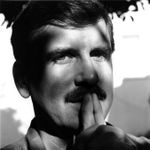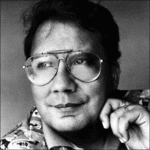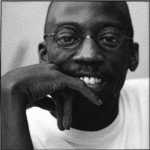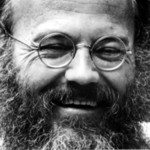I’ve been on the road, as I mentioned, attending the Lammys, visiting the ONE Archives and now back in New York City for the Cockettes celebration of the donation of the Martin Worman Archives to the NY Public Library. Whew!
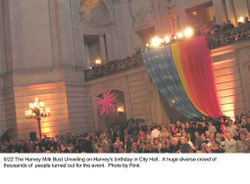 But no…I have not forgotten the one event I was UNABLE to attend personally: The dedication of the Harvey Milk Memorial bust at San Francisco City Hall on May 22. We had two intrepid reporters in attendance on our behalf, Andrew Ramer and Lee Mentley (two more intrepid people I dare say don’t exist!) I will try to relate their reportage here. Andrew wrote about 5,000+ words about it. Lee and I spoke about it at the Cockette’s performance in in New York at the Theater for the New City on Monday. Let’s start with that.
But no…I have not forgotten the one event I was UNABLE to attend personally: The dedication of the Harvey Milk Memorial bust at San Francisco City Hall on May 22. We had two intrepid reporters in attendance on our behalf, Andrew Ramer and Lee Mentley (two more intrepid people I dare say don’t exist!) I will try to relate their reportage here. Andrew wrote about 5,000+ words about it. Lee and I spoke about it at the Cockette’s performance in in New York at the Theater for the New City on Monday. Let’s start with that.
Lee was almost at a loss for words about the event, he said. But the thing that struck him most deeply was the effect it had on the young people who were in attendance. "For most of these kids, they didn’t really have a clue. Who the heck is Harvey Milk? They weren’t even born yet! But by the time the event was over, you could see a real change in their eyes. They were crying, some of them. They had a whole new sense of themselves, their history, the place in which they were standing even."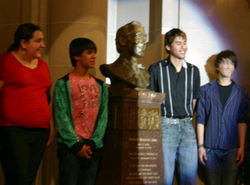
History has a way of doing that. Huh? Our children need their roots, their history, just like everyone else.
Andrew’s moving account of the proceedings, in his own words, is not meant to be a full account of the day. We don’t usually post such long pieces on the blog. But this is worth the time and space. In case you don’t make it all the way to the end of this moving piece, please give an extra bit of thanks to Rink, who graciously gave us permission to use his wonderful photos to illustrate this post, this story, this historic event…:
 You may remember the biblical story of the patriarch Jacob, who dreamed about angels going up and down a ladder or stairway to heaven. Connecting matter and spirit was to me the theme of the ceremony, which took place at the foot of the great staircase in the Rotunda of San Francisco City Hall, a stately Beaux Arts edifice built after the destruction of its equally ornate predecessor in the 1906 earthquake.
You may remember the biblical story of the patriarch Jacob, who dreamed about angels going up and down a ladder or stairway to heaven. Connecting matter and spirit was to me the theme of the ceremony, which took place at the foot of the great staircase in the Rotunda of San Francisco City Hall, a stately Beaux Arts edifice built after the destruction of its equally ornate predecessor in the 1906 earthquake.
Before walking over to City Hall, I had dinner with my very good friend Andréa Guerra, a photographer and artist who’s done a series of watercolors and collages of Jacob’s ladder. We were eating at Red Jade on Church Street, our favorite Chinese restaurant. Two men were sitting at the table behind her, both longhaired and bearded, about my age or a bit older, wearing not quite matching green shirts and kilts. I wondered if they were dressed up because they too were going to the ceremony. We got to City Hall at around six, mounted the front stairs with others, slowly passed through the security line, and made our way into the Rotunda, after being handed a program guide, brochure, and postcard for the event. I noticed with pleasure the White Crane logo on the back of the program guide. Was my behavior petty and tribal? Yes, but it isn’t every day that I attend a memorial celebration for a fellow Gay Jew, and I was proud to be there on behalf of White Crane, who supported the project and were cosponsors of the ceremony.
A very large rainbow flag hung over the entrance to the Rotunda, pulled to one side, making the vast formal space look rather like an Edwardian drawing room on acid. As we entered the Rotunda, Andréa pulled out one of her two digital cameras, I pulled out my little spiral notebook and clear plastic fountain pen, and we began to move through the crowd. Six or seven rows of folding chairs were set up in a semi-circle at the base of the monumental stairs leading up to the chamber of the Board of Supervisors. Two very large screens up on the mezzanine, on either side of the stairs, were showing photos of Harvey. Panning the room I saw the two men in green, one’s nose ring catching the light. To the right of the Rotunda, in the North Light Court, an even larger screen flashed the White Crane logo. 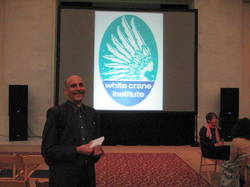 I sat down in one of the empty chairs arranged in rows in front of the screen to watch the rest of the black-and-white pictures of Harvey and see all the sponsors’ logos when they came up again.
I sat down in one of the empty chairs arranged in rows in front of the screen to watch the rest of the black-and-white pictures of Harvey and see all the sponsors’ logos when they came up again.
What a different era those pictures revealed. Men in tee shirts and jeans, slim, no gym bodies that I could detect, young and hopeful in that wonderful time after Stonewall and before AIDS, when it seemed that everything good was coming our way. Pictures of Harvey at different times in his life, laughing, smiling, marching, in one of Robert Lentz’s icons, on a postage stamp, and my favorite – Harvey as a little boy with very big ears sitting on top of a horse. Those ears were tuned, it seemed to me, to the very pulse of the world around him. Sad and strange that this would have been his 78th birthday. Several times my eyes welled up with tears, not just from the pictures of his coffin lying in the same Rotunda, of candles, shattered glass, but also from looking at him smiling. Smile iconic, and now duplicated in the bust of him to be dedicated later. His smile reaching out and embracing, just as much as his ears were transceivers taking in. I believe in the immortality of the soul. I do not believe in predestination. I do believe that all souls choose to come here. But we queers have so few heroes, and for him to have been gunned down in his prime, in what has sometimes felt to me our prime. Oy!
The people in those pictures were very different too from most of the people in the room, although some of them were probably the same people. Formal wear, jackets and ties had replaced tee shirts and jeans, although there were a few people dressed that way and Harvey’s jackets and ties were part of his official life as a city politician. Wandering through the crowd I saw almost no leather, some drag, including Jack Davis, local artist and Radical Faerie, in a wedding gown and veil whose whiteness matched his beard. The feeling in the crowed space was festive. And yet here and there I saw a face that carried pain, and I wondered – Is that a friend of Harvey’s, someone for whom this birthday party is also a night of deep loss and continuing grief?
Servers wandered through the crowd carrying small white plates of finger food that I was too nervous to eat. What was I supposed to be doing? I told White Crane co-editor Bo Young that I would go, and write about the evening for the White Crane blog. But I don’t go online very often and have only seen one blog ever, my friend Patanjali’s cooking blog, yet there I was with a small spiral notebook and fountain pen. As I moved through the room I kept distracting myself from the task at hand by this thought – In a state where same-sex marriage has been recently declared kosher, is my husband, as yet unmet, about to cross my path? (He didn’t.)
Andréa and I wandered back and forth from the Light Court to the Rotunda, she taking pictures and me making notes. I rather liked the twisty rainbow-colored balloons that were hanging from archways around the Rotunda. To me they resembled gigantic octopuses, tentacles reaching out and making connections. In the Light Court there were similar creations on top of columns of balloons, which Jeff, an old friend from the Gay Spirit Visions Conference, pointed out to me were not the sea creatures on sticks they appeared to me but balloon palm trees. Even though palm trees are not native to this area they have been planted all over the city, a city in which so many of us come from stock that is native to other regions.
 In the midst of jackets and ties a Sister of Perpetual Indulgence wandered through the crowd. John Burnside, life-partner of Harry Hay, was seated in the Rotunda in elegant black, a bright red flower on top of his hat. I ran into friends from my synagogue, including one who had been a friend of Harvey’s, who told me a few stories about him. She wasn’t out yet the first time they met and she went up to him and said, “If you were straight I’d go out with you.” She also shared these words of his, as we stood at the base of the monumental staircase leading up to his not yet unveiled bust: “Those stairs belong to us like they belong to all people.”
In the midst of jackets and ties a Sister of Perpetual Indulgence wandered through the crowd. John Burnside, life-partner of Harry Hay, was seated in the Rotunda in elegant black, a bright red flower on top of his hat. I ran into friends from my synagogue, including one who had been a friend of Harvey’s, who told me a few stories about him. She wasn’t out yet the first time they met and she went up to him and said, “If you were straight I’d go out with you.” She also shared these words of his, as we stood at the base of the monumental staircase leading up to his not yet unveiled bust: “Those stairs belong to us like they belong to all people.”
So much has changed since Harvey Milk said those words. We know that those stairs are everyone’s, at least here in San Francisco. We live our lives because people like Harvey had the courage to come out and act on our behalf, I thought, as I moved back to the Light Court, stopping to look at the technology that made the evening possible. Two laptops on a table at the side of the stairs seemed to be running the slideshow. A CD player was giving us music. All together there were 8 monitors and wired devices that I cannot name or identify, that did not exist when Harvey was alive. I wondered what he would have thought of them, and imagined that he might have envied the increased capacity for communication they would have allowed him.
The ceremony began around 7 when MCs writer Jewelle Gomez and local activist Cecilia Chung introduced Mayor Newsom. A long line of politicians joined him at the bottom of the stairs, all men in suits till Carole Migden joined them. Later I found out that the mayor was scheduled to speak first and the other politicians weren’t supposed to come up till after a group of Harvey’s friends had come down the stairs and spoken to the gathering. Our cute straight raspy-voiced mayor, who has demonstrated his ability to be our ally, spoke about Harvey and his legacy. He and the other politicians, including Tom Ammiano and Mark Leno, reminded us that we all stand of the shoulders of other people, that our struggle is linked to that of other people, and spoke about Gus Van Sant’s film about Harvey that will be out soon, starring Sean Penn. The screenwriter was in the audience, I believe. Carole Migden said this of Harvey: “He was a warrior. He wasn’t mainstream.” Jose Cisneros moved me when he said, “We’re in Harvey Milk’s house. That bust at the top of the stairs won’t let anyone forget that.” And Gerardo Sandoval told us about Harvey’s having been an inspiration to him and other Mexican-Americans, another reminder that our work is not isolated, that having friends and allies, and being friends and allies, is part of our spiritual and political work.
For me, and I think for others in the hall, the dedication really began when the politicians stopped speaking and Connie Champagne, local performer and songwriter, sang “Over the Rainbow.” Yes, it’s a cliché, weighed down by allusions, and yet it still called out to me. Standing in the crowd I felt elation and sorrow wash through my chest. I couldn’t have imagined anything like this happening when I came out in 1973, way across the bay in Berkeley – the dedication of a memorial to the first openly Gay person erected in a seat of government anywhere in this country.
Tears welled up as a group of Harvey’s friends came down the stairs. Anne Kronenberg spoke as their representative. She’d worked as an aide for Harvey and told us that the city used to literally roll a red carpet down those long stairs to the front doors of the building for visiting dignitaries, and Harvey loved to prance up and down those stairs, pretending he was one of those dignitaries. Tears followed by laughter, imagining him doing that.
Two performers sang a song written for the occasion, “Give Them Hope,” inspired by and with words taken from Milk’s speech of the same name. (The sound system wasn’t quite adequate and I missed several parts of the evening, including most of a recording played later, in which Harvey repeated some of the talk and in which he discussed his fears of being killed, and what he wanted to be done if that happened.)
I want to mention the Bob Ross Foundation, major sponsors of the memorial, and the team of artists who created it, Eugene Daub, Rob Firmin, and Jonah Hendrickson. And I have to mention the wonderful pairing of the co-chairs of the Memorial Committee, Joey Cain and Dan Nicoletta, who worked for Harvey and whose photo inspired the bust of him. Dan wore an elegant jacket and tie whose formality held one end of the spectrum, while Joey wore a black hat over his flowing hair, a bright red shirt with black polka dots, a light-colored bow tie, and multicolored pants that stood out in the crowded dun-colored space. Cain told a moving story about one of the people involved in the project. Charlotte Coleman owned a number of lesbian and Gay bars in the 1960s and 70s. Right after Harvey’s death she started a fund for some sort of memorial, but forgot about it during the AIDS crisis and only remembered it after reading about the project in one of the local Gay papers. When she tried to track down the money she discovered that the state had seized the account as being unclaimed. After doing all the work necessary to reclaim it, Ms. Coleman had $5000 to contribute, an inspiration to those of us who move slowly and doubt the results of our well-intended deeds.
I was also moved by the words of Harvey’s nephew Stuart Milk, who spoke of belonging to both of Harvey’s families, his LGBT family and his birth family, and who bore to my eyes a strong physical resemblance to Harvey. A teenager when his uncle was assassinated, he told us that he came out to Harvey at his grandfather’s funeral and recalled his uncle’s advice to accept himself, something that many of us still struggle to do. The mayor presented a plaque to him declaring May 22 Harvey Milk Day, or at least I think that’s what he said. Again, the sound quality wasn’t very good.
The San Francisco Gay Men’s Chorus sang next, looking dashing in their tuxedoes, followed by a procession of diverse community members, who also came down those long marble stairs. The event concluded with the descent of a group of nine young people ranging in age from ten to eighteen, representing different youth groups in the city. Several were from the Gay Straight Alliance Network, one was from Larkin Street Youth Services, and a ten-year-old attends the Harvey Milk Civil Rights Academy. After coming down the stairs, to the applause of those of us assembled, the representatives of our queer future marched back up to the landing in front of the chamber of the Board of Supervisors. I watched from below on those two huge video screens as a fanfare played and they slowly struggled to pull off the long blue fabric that covered the statue. It was so like an unveiling at a Jewish cemetery, which usually takes place a year after someone’s death, when a gravestone is ritually uncovered. So heartbreaking and yet so necessary a part of the process of grief, loss, and also gratitude, however long delayed the ceremony turns out to be.
The fabric reminded me of the blue stripes on a tallis, a Jewish prayer shawl, flowing like water in the hands of those nine young people. Filled with sorrow and joy I turned in the opposite direction and read on the high Rotunda wall these words engraved into the stone, written in the archaic style I remember from my childhood, that would have been familiar to Harvey too, in Roman letters where U and V are the same:
SAN FRANCISCO
O GLORIOVS CITY OF OVR
HEARTS THAT HAST BEEN
TRIED AND NOT FOVND
WANTING GO THOV WITH
LIKE SPIRITS TO MAKE
THE FUTVRE THINE
Surely those words were meant to be a reminder of the catastrophic quake of 1906 and its rebuilding afterwards, but I read them as a testament to the murder of Milk and Mayor George Moscone on November 27, 1978, and then the beginning of the AIDS nightmare that started three years later. San Francisco has been a model to the rest of the world, and that night I felt the energy of this city’s genius pulsing in that vast domed space where not so many years ago nearly 4000 same-sex couples were wed, and where, hopefully beginning this June, such marriages will be performed again. To make the future ours.
After the unveiling, was I the only one who choked on words as we all stood and sang Happy Birthday to Harvey? I doubt it. Although I never met him, his life touched mine in a profound way, and I knew that I was standing there, pen and red-covered pad in hand, because of all the ways in which that Gay Jewish man’s life work made my own life and work possible.
Andréa and I joined the throng gathered at the foot of the stairs, slowly ascending them to view the newly unveiled statue. Those stairs – there are many of them. Eight from the floor of the Rotunda to the first landing. Twenty-eight more to the second landing. Then six more steps till we arrived at the landing where the memorial stood, beside a supporting column to the right of the entrance to the Board of Supervisors’ chamber.
The statue. A bust of Harvey that seems a tad larger than life. The bust, perhaps a tad higher than Harvey was tall, smiling, tie blowing in the wind, shirt lapels not as long and pointy as in Dan Nicoletta’s photograph. People were going up to the statue, standing beside it, throwing their arms around it, laughing, smiling, as several photographers took pictures of them. The Milk Memorial is the 13th such statue in the building, designed to fit into the elegant Beaux Arts structure. Almost all of the other statutes are of former mayors, an engineer, a major general. But I somehow doubt that people were throwing their arms around their statues when they were dedicated, as almost everyone was doing with Harvey’s. As if the statue were Harvey himself, his warmth even all these years later, his warmth and sincerity, inviting a familiarity that may also come from his Gayness, Gay in both senses of the world. It didn’t look as if people were hugging a monument, but rather that they were embracing one of us, a friend.
Wandering out into the cold night I continued to feel warm inside, sad inside, grateful, moved that I had been there, and torn apart by the violence of this world and the struggle we go through to make it a better place. When I got home I took off my black jeans, gray shirt, blue and black checked jacket with a blue and white rhinestone flower pin on its lapel, given to me by White Crane co-editor Dan Vera. I got into my chilly bed, sad and energized by the evening, beginning to assemble these words beneath my bald pate.
Co-chair Joey Cain was kind enough to speak with me by phone the next morning. He told he that the 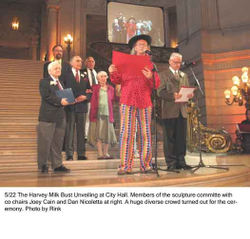 reason he got involved was: “I never agreed with Harvey when he was alive. I was an advocate of overthrowing the system, not joining it. Harvey and I had very vocal arguments on Castro Street. But over time I realized that we have to do all of it, including change the system.” He went on to say that, “For me our work was about the queer community being recognized in a governmental building. Equal to going into the Library of Congress and seeing Walt Whitman’s name on the ceiling, I want Harvey in San Francisco City Hall for people 100 years from now, this Gay person who was important. More than for Harvey, I did it for the people.” His words echoed Harvey’s words, now preserved in stone.
reason he got involved was: “I never agreed with Harvey when he was alive. I was an advocate of overthrowing the system, not joining it. Harvey and I had very vocal arguments on Castro Street. But over time I realized that we have to do all of it, including change the system.” He went on to say that, “For me our work was about the queer community being recognized in a governmental building. Equal to going into the Library of Congress and seeing Walt Whitman’s name on the ceiling, I want Harvey in San Francisco City Hall for people 100 years from now, this Gay person who was important. More than for Harvey, I did it for the people.” His words echoed Harvey’s words, now preserved in stone.
Joey told me that the artists envisioned a contemplative monument that would be a source of pilgrimage in the city, and he too spoke of the importance of the stairs, to Harvey and to the evening. They planned the ceremony so that all the participants would come down those stairs and go up them, up to the mezzanine where Harvey’s bust was to be unveiled. He reminded me that the event took place fifty yards from where Harvey was shot, and told me another anecdote, that Harvey used to say, “When Gay people go to City Hall, don’t take the elevator, take the steps, so that everyone knows we’re there.”
The next morning I walked my Gay self back to City Hall. I wanted to be in that space by daylight and see the memorial without all the crowds. There was no evidence that anything had gone on the night before. No rainbow palms, no rainbow flag. The crowds were gone but the Rotunda wasn’t empty. I’d forgotten that the small circular space at the top of the stairs is the site of numerous weddings. I slowly mounted the stairs and got the top as a wedding was in progress. I watched the next wedding from beginning to end, and stayed to watch one more, with other couples lined up below waiting their turn. Of course, as it isn’t June yet, and I’m still not convinced that the Supreme Court’s decision will become a reality, all of the couples marrying were straight. Some wore formal garb, some casual, all said their vows beneath the frozen gave and frozen smile of a Gay man who none of them seemed to notice. Nor did the black-robed woman who stood facing Harvey, who in less than five minutes was binding those couples together according to the laws of the state of California.
Slinking along the side of the landing, not wanting to intrude, I took time to look at the monument as I hadn’t done the night before, when I didn’t want to linger and be photographed. In the filtered light of day the stone pedestal, of mottled chocolate marble, was glowing soft and warm. I’d read that the designers were not originally in favor of the site but came around to it and grew to appreciate its rightness. I stood for a while staring up into Harvey Milk’s eyes, a bit higher than my own. Who was this man, I wondered, whose kind face reminded me of my Uncle Manny, a Queens New York dentist I adored as a child? Would Harvey and I have liked each other? Seen eye to eye in life, two Gay Jewish men from adjacent generations, both of us from Long Island? I’ll never know. But in our different ways the two of us stood there while a wedding went on behind me, as I read the words on the memorial and copied them in my little pad.
HARVEY BERNARD MILK
MAY 22, 1933
NOVEMBER 27, 1978
SAN FRANCISCO SUPERVISOR
JANUARY 9 – NOVEMBER 27, 1978
I ASK FOR THE MOVEMENT
TO CONTINUE.
BECAUSE MY ELECTION GAVE
YOUNG PEOPLE OUT THERE HOPE.
YOU GOTTA GIVE ‘EM HOPE.
HOPE SPEECH 1978
GIFT OF THE BOB ROSS FOUNDATION
AND DONORS FROM AROUND THE WORLD
So sad, so strange. A strong vital face staring at me. So absent, the man. So present and enduring his tribute in metal and stone, till the next great quake rumbles beneath us.
The early thirty-something photographer for one of the weddings came up to the statue and with a chuckle asked the older gentleman who came with him, “Who was that? The inventor of powdered milk?” The gentleman looked at me and stumbled to explain. I took over, telling him about the ceremony the night before, about how Harvey was assassinated not fifty yards from where we were standing. Did what I was saying register? I don’t think so. He was there on other business and returned to it. And I turned back to the memorial.
Beneath the bust are three bas-reliefs that give voice to some of what the bust itself doesn’t say. On the left-hand side, taken from another photograph, we see Harvey in tee shirt, left fist raised, a lei around his neck, balloons behind him, (were they rainbow colored?) sitting on top of a car. The words on this relief read, “Gay Freedom Day.” On the right, also from a photograph, we see Harvey in uniform beneath these words, “US Naval Officer 1955.” But it’s the relief in front that will tell visitors a bit more about the man and his place in our community. “Candlelight March November 27, 1978.” Ten people move across the relief from right to left, all carrying candles. A woman alone, a man alone, then two women with their arms around each other, two men holding hands, another woman alone, another man, and then what looks like a mother and her child bringing up the end of the march. These are not the words I would have put on a monument. Mine would have read, “Gay Jewish Supervisor.” My memorial would not have been stone but something luminous, perhaps a tall glass pillar with an image of Supervisor Milk on it, wearing a pink triangle arm band. Instead I stood before a subtle and beautiful monument that fits into the building with more natural elegance than any of the others I could find, and I went to visit all of them.
 Directly across the Rotunda, on the far side of the mezzanine, beneath a row of flags, I saw Mayor Newsom smiling and laughing with what looked like a visiting family as cameras flashed. Was he thinking about the preceding night? Was he looking at the children in the family and wondering if any of them were queer, as I was? Did he walk them all around the mezzanine to see Harvey’s memorial? And did he tell them about the amazing birthday party for a dead man he’d attended the night before? I hope so.
Directly across the Rotunda, on the far side of the mezzanine, beneath a row of flags, I saw Mayor Newsom smiling and laughing with what looked like a visiting family as cameras flashed. Was he thinking about the preceding night? Was he looking at the children in the family and wondering if any of them were queer, as I was? Did he walk them all around the mezzanine to see Harvey’s memorial? And did he tell them about the amazing birthday party for a dead man he’d attended the night before? I hope so.
On Saturday afternoon I caught up with Dan Nicoletta, the other co-chair of the memorial, who like Joey Cain was kind enough to answer my questions by phone. I wanted to know where and when he’d taken the picture of Harvey that was used to create the bust of him. He told me that he’d taken it in front of Harvey’s camera store, circa 1977. When I commented on his elegant outfit he said, “I knew I would have some competition in the fashion department so I chose something smart but subtle.”
I wondered how the evening was for him, if beneath the joy there was sorrow. His answer: “Maybe it hasn’t hit me yet. I felt very even that night. Welled up at times but did not experience highs and lows. I was very happy with evening and complete with the project.” Then, being not just an elegant dresser but also my Great Aunt Mina’s idea of a perfect gentleman, he offered his thanks to White Crane for showing up and participating in the project. Another lovely tribal moment of pleasure.
I was curious what it was like for him as an artist to see his two-dimensional image of a living three-dimensional friend turned back into three bronze dimensions. At first he talked about the photo itself. “There’s elan in that moment, tie blowing in the wind. Time frozen. Harvey’s smile.” He told me that sculptors usually avoid open-mouthed smiles in bronze because they’re hard to do, but the team wanted to show Harvey’s smile. When I asked Dan what it was like for him to see a bust crafted from his own work he added, “It was really such a great honor metaphysically and physically. The sort of honor every artist longs for. A very high coolness factor.” Reminding him of White Crane’s mission to be a voice for Gay wisdom and culture, I asked him for a comment. He echoed Joey Cain’s words: “The one thing we hoped for as a committee is that the memorial becomes a place of pilgrimage, not just to Harvey Milk’s legacy but to the LGBT movement. A visiting spot for everyone coming to this city, to give them a sense of awe at the political process and their ability to participate in it. That’s what Harvey wanted and that was the goal of our work.”
Dan also told me that creating the memorial was an incredible exercise in community building, and all of that can be felt when you stand facing it. “Harvey’s reputation has ebbed and flowed over the years,” he said, and when the project was initiated in 2004 there was a low ebb of interest in his memory. That year there were 15 people at the candlelight march, 14 of them elected officials, and the group was fag based crossing Castro Street. But, he added, “Stalwart people were determined to do it, and we did.” 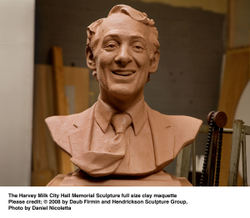
75 inches high, weighing more than 200 pounds, of bronze and marble, at the top of all those stairs, a smiling man stares out into the vast Rotunda. I believe in the immortality of the soul. I don’t know, in a vast multi-dimensional universe, if Harvey was at the ceremony. Who can say what other adventures the dead are engaged in, what other things they have to explore, what other places? But when/if same-sex couples gather again on that landing at the top of the stairs, I hope that they will remember to thank Supervisor Harvey Milk for the work he did to pave the way toward their marriage being legal.
Carole Migden reminded us that, “We won the right to marry. Not that Harvey ever would.” Or, would he have changed his mind if he had lived longer? Would he have been involved in getting same-sex marriages legalized sooner? And one day, in the midst of his active life, would he have met a man so compellingly right that eventually he would have gotten down on one knee to do something old fashioned? Would they have had invitations printed up, and would Harvey have walked up those cold marble stairs, perhaps as the governor of the state of California or the president of the United States, his hand warm in the hand of another man? And when they stood before a judge, in the city Harvey called Home, in the presence of family and friends, when he said, “I do” and had those sweet words echoed back to him – would a fellow Gay Jew with a pad and fountain pen have been standing in the corner, watching, making notes, thinking about Jacob’s ladder and how these two had just ascended it together, embodied angels? This fantasy of mine is what murder robbed him of, robbed us all of, the rest of his story, however he would have lived it out. And this is what we must do in his absence, not just make pilgrimage to the shrine, but make of our lives… Oh, you know this. Enough. Go and do.

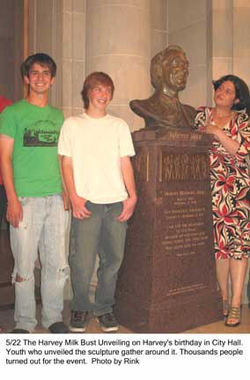
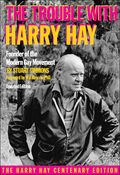

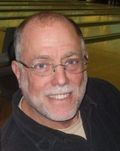
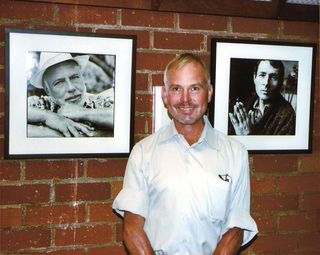

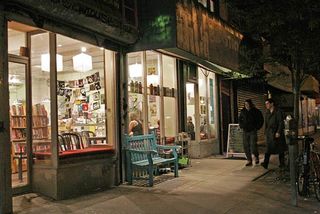
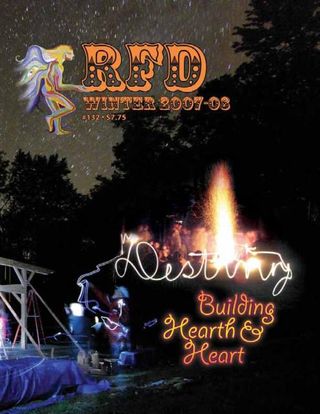
















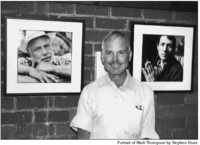
 Bo Young:
Bo Young: